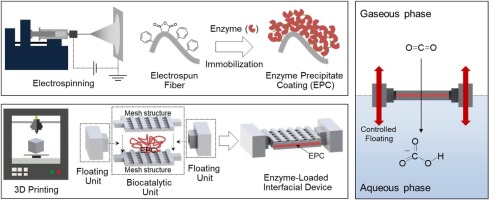Journal of CO2 Utilization ( IF 7.7 ) Pub Date : 2020-02-20 , DOI: 10.1016/j.jcou.2020.02.005 Han Sol Kim , Sung-Gil Hong , Jusang Yang , Youngjun Ju , Joongbok Ok , Seok-Joon Kwon , Kyung-Min Yeon , Jonathan S. Dordick , Jungbae Kim

|
Carbonic anhydrases (CAs) are enzymes that can function at physiologic interfaces and catalyze the interfacial conversion of carbon dioxide (CO2) into bicarbonate (HCO3−) with an extraordinarily high catalytic efficiency. Even though CAs have potential to be used for CO2 sequestration, significant mass transfer resistance and poor enzyme stability at gas-liquid interface often limit the effectiveness of the enzyme. Here, we report a density-adjustable 3D-printed platform, which can accommodate electrospun polymer fibers with immobilized CA and enable the positioning of immobilized CA in an air-water biphasic system. By using 3D printing, we fabricate interfacial devices consisting of two floating units and different number of biocatalytic units. Two mesh structures of each biocatalytic unit are used to sandwich immobilized CA while two floating units, connected on either side of the biocatalytic units, have an internal hollow volume that enables controlling the position of the enzyme-loaded interfacial device at or near the air-water interface. The positioning of interfacial device directly at the biphasic interface accelerated CO2 conversion by 1.8- and 3.4-fold when compared to reactions performed with immobilized CA within the aqueous solution and a control interfacial device without immobilized CA, respectively. The CA-loaded interfacial device retained 99.3 % and 88.2 % of its initial CO2 conversion rate after ten recycles and after subsequent storage in an aqueous buffer at 4 °C for 459 days, respectively. Facile combination of interfacial devices and immobilized enzymes on polymer fibers has paved the way to practical uses of biocatalysts for interfacial CO2 sequestration.
中文翻译:

用于气液界面生物催化CO 2转化的3D打印界面装置
碳酸酐酶(CA)的酶是在生理接口可以功能和催化二氧化碳的界面转化率(CO 2)转换成碳酸氢盐(HCO 3 - )具有非常高的催化效率。即使CA有潜力用于CO 2螯合,明显的传质阻力和气液界面处的酶稳定性差通常限制了酶的有效性。在这里,我们报告了一种密度可调的3D打印平台,该平台可以容纳带有固定CA的电纺聚合物纤维,并使固定CA在空气-水双相系统中的定位。通过使用3D打印,我们制造了由两个漂浮单元和不同数量的生物催化单元组成的界面设备。每个生物催化单元的两个网状结构用于将固定化的CA夹在中间,而连接在生物催化单元两侧的两个漂浮单元则具有内部中空体积,该体积可控制负载酶的界面设备在空气中或附近的位置。水接口。2相比,水溶液和未进行固定化CA分别控制界面装置,内用固定化CA进行的反应时转化通过1.8和3.4倍。加载了CA的界面设备在十次循环后以及随后在4 ° C的水性缓冲液中存储459天之后,分别保留了其初始CO 2转化率的99.3%和88.2%。界面装置和固定化酶在聚合物纤维上的简便组合为生物催化剂用于界面CO 2隔离的实际应用铺平了道路。


























 京公网安备 11010802027423号
京公网安备 11010802027423号